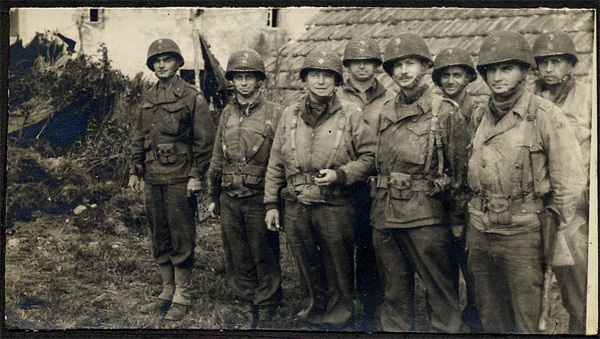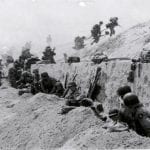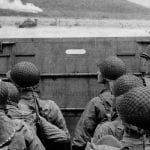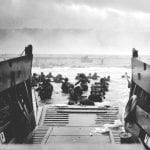The following article on the 29th Infantry Division is an excerpt from Barrett Tillman’ D-Day Encyclopedia. It is available for order now from Amazon and Barnes & Noble.
Part of Maj. Gen. Leonard T. Gerow’s V Corps, the 29th Infantry Division was organized from Virginia, Maryland, Pennsylvania, and District of Columbia National Guard units and was inducted into federal service on 3 February 1941. The mixture of ‘‘North and South’’ inspired the division’s blue-gray emblem worn on helmets and uniforms—the monad, a Korean yin-and yang, symbolized eternal life.
The division was activated at Fort Meade, Maryland, in February 1941, Maj. Gen. Milton Reckford holding command for the first twelve months. Gerow then took over, and the 29th Infantry Division sailed from the East Coast in October 1942, becoming the first U.S. Army division to arrive in Britain. When Gerow was promoted to command V Corps in July 1943 he was followed by the flamboyant Charles H. Gerhardt. By then the Twenty-ninth had been in England eight months, training for D-Day. The major components were the 115th, 116th, and 175th Infantry Regiments, plus four field artillery battalions, three tank battalions, and three tank destroyer battalions. On D-Day the 116th was attached to the First Division, sustaining serious casualties in the surf from German fire along the bluffs.
- 115th Infantry: Col. Eugene N. Slappey.
- 116th Infantry: see First Infantry Division.
- 175th Infantry: Col. Paul R. Goode.
Following the 116th, most of the 29th Infantry Division was ashore by that night. In the next few days the 115th advanced to the River Aure at Longueville, while the 175th liberated Isigny.
The Blues and Grays played a major role in seizing Saint Lo, an important road junction, on 18 July. The division was heavily involved in the breakout from Normandy and the campaign through Brittany, culminating in the seizure of the vital port of Brest. From there the ‘‘29ers’’ fought through Holland and finished the war at Hanover, well east of the Rhine. In eleven months of combat the Twenty-Ninth had sustained 20,300 casualties (4,780 dead), fourth highest among all U.S. Army formations.
This article is part of our larger selection of posts about the Normandy Invasion. To learn more, click here for our comprehensive guide to D-Day.
 |
 |
 |
This article is from the book D-Day Encyclopedia, © 2014 by Barrett Tillman. Please use this data for any reference citations. To order this book, please visit its online sales page at Amazon or Barnes & Noble.
You can also buy the book by clicking on the buttons to the left.
Cite This Article
"29th Infantry Division: North and South Meet" History on the Net© 2000-2024, Salem Media.
April 20, 2024 <https://www.historyonthenet.com/29th-infantry-division>
More Citation Information.










